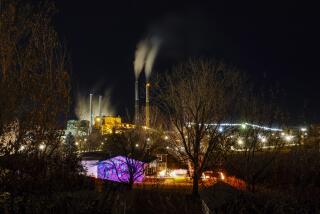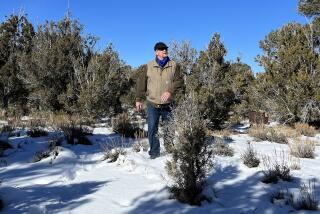Wildlife, Gas Fields Squeeze Into a Key Migratory Corridor
- Share via
PINEDALE, Wyo. — The cluster of mule deer munching on sagebrush peeking out of the snow seems unfazed by the screeching, whooshing and clanging from the drilling rig less than 100 feet away.
But as they quietly graze on this wind-swept plateau in southwestern Wyoming, these animals are at the center of an intensifying tug of war over the fate of vast stretches of federal land in the Rocky Mountains.
Their chosen feeding spot on this frigid winter day, the Pinedale Anticline, has been a crucial winter range and migratory corridor for big game for thousands of years. During the winter, it hosts Serengeti-like congregations of animals -- some 100,000 mule deer, pronghorn, moose, elk and bighorn sheep. In the last few years, it has also become a booming natural gas field, supplying clean energy to heat and cool houses and fuel electric power plants in California and elsewhere in the West.
The anticline is a broad stretch -- 35 miles long and six miles wide -- of relatively flat land between two majestic mountain ranges, the Wind River and Wyoming, that creates a natural corridor for wildlife. Underlying it is a geological formation, 14,000 feet deep, where pockets of natural gas lie trapped in sandy soil.
Gas production in the anticline was supposed to be a model of how energy could be extracted without destroying other uses of the land, such as wildlife habitat and big-game hunting. From the beginning, the federal government involved local environmentalists, landowners and wilderness outfitters in planning for the field. Operators were required to vacate sensitive areas when game were grazing or sage grouse were mating and were encouraged to minimize surface disturbances.
Now, the gas field is being developed at least twice as rapidly as predicted, and gas companies and local hunting and conservation communities sharply disagree over whether enough is being done to protect the wildlife. To Courtney Skinner, 67, who with his brothers runs an outfitting business in Pinedale, the answer is a resounding “no.”
“They’re moving very, very rapidly and pushing the number of wells way beyond reason,” said Skinner, who has lived in Pinedale since childhood.
To Ron Hogan, general manager of the Pinedale operations for Questar Corp. of Salt Lake City, the presence of mule deer next to his natural gas company’s rig shows that wildlife and drilling can peacefully coexist.
“Environmentally, it’s the cleanest thing we have available,” Hogan said. “You would think they’d be excited about developing it.”
Four years ago, the federal government gave operators permission to construct 700 producing well pads on the anticline over 10 to 15 years, but banned drilling from Nov. 15 to April 30 because of the importance of the range to the herds in winter. But for the second consecutive year, the Bureau of Land Management, which administers these federal lands, has granted Questar an exception, allowing the natural-gas company to drill multiple wells from a single pad through the winter. By drilling directionally, or at an angle, rather than straight down, more than one well can be based on a single pad -- a technique that minimizes surface disturbances.
The exception granted Questar exemplifies the Bush administration’s efforts to expedite energy production on public lands across the West. Administration officials say they will consider other attributes of the land -- such as clean water and wildlife habitat -- as they streamline drilling in the Rocky Mountains.
But biologists, hunters and conservationists warn that development here and elsewhere in the Upper Green River Basin threatens herds of game that summer in Grand Teton National Park and other wild areas. Similar concerns are heard up and down the Rocky Mountains as the administration moves to allow gas development from the Rocky Mountain Front in Montana to Otero Mesa in New Mexico.
Questar’s goal is to persuade the bureau to permit expansion of winter drilling to at least three well pads, each with two rigs. The company is funding a study on the impact of energy development on the mule deer population in hopes of bolstering its case. In exchange for being allowed to drill year-round, the company pledges to cluster several wells on each pad and use directional drilling.
Hall Sawyer, the chief biologist for the company study, says that the presence of mule deer so close to the Questar rig may not prove that the animals are unharmed by development. And even if the deer have adapted to one rig, he notes, it does not necessarily mean that the animals could adjust to the presence of additional rigs and traffic.
Longer-term measures, such as birth rates, are truer indications of whether or not the herd is being harmed, biologists say.
Because of harsh conditions and scarce food, deer are vulnerable during winter. Any extra expenditure of energy, such as a sprint provoked by a passing truck, could result in lower rates of survival and reproduction, said Sawyer, a wildlife biologist for Western EcoSystems Technology, an environmental consulting firm in Cheyenne, Wyo.
“The whole basin is getting chewed up,” Sawyer said. “Folks have always had the view, ‘Let’s develop here and the animals can go over there.’ We’re starting to get to the point now that there is no ‘over there.’ ”
Fueling concerns about the anticline’s fate is the development just to the south, the Jonah Field. In five years, operators have drilled 468 wells on the field, bulldozing 14% of the 45-square-mile area for well pads, roads, pipelines and production facilities. Now the bureau is considering a request to expand development to 3,100 wells and bulldoze as much as two-thirds of the total area.
Pronghorn antelope migrate through the field and are considered vulnerable.
“If we don’t do something to assure the continuance of the migration, what we’ll be saying is that it’s OK to let a species go extinct in a national park,” said Joel Berger, a local biologist who works for the Wildlife Conservation Society, an environmental group in New York.
Keith Andrews, a bureau biologist, said that so far the pronghorn still traversed Jonah, but he acknowledged that migration patterns could change once drilling becomes more concentrated.
Officials at the Wyoming Game and Fish Department, the state wildlife agency, say that unless many of the permits for Jonah Field and the Pinedale Anticline mandate the use of directional drilling, a large number of game will perish.
“We’d see significant losses of mule deer and antelope because they wouldn’t have enough habitat to sustain them,” said Bernard Holz, Pinedale supervisor for the department.
However, industry officials say that directional drilling may not be possible in Jonah because so many straight wells have already been drilled.
Bureau officials said they would weigh both concerns when deciding about the expansion.
“We clearly understand there is a world-class wildlife resource and there’s also a world-class gas resource,” said Robert A. Bennett, Wyoming state director for the land bureau. “We probably can’t protect all that critical wildlife habitat, and we may not fully develop the gas resource.”
But the Bush administration’s consistent message to the bureau’s field offices across the Rocky Mountains has been to make energy development a top priority.
For instance, as part of the bureau’s effort to rewrite management plans for the vast lands under its jurisdiction, acting director Jim Hughes wrote to state directors in September, instructing them to review all environmental restrictions or stipulations to energy development to ensure that the required “mitigation is the least restrictive necessary to accomplish the desired protection.”
And, said Tom Lonnie, the bureau’s assistant director for minerals, realty and resource protection, these efforts are paying off. The number of drilling permits approved across the West increased from 3,000 in 2000 to about 4,000 last year, he said.
One decision that stands to have a big impact on the fate of big game here is whether to allow drilling in an area just northwest of Pinedale, around a key migration bottleneck known as Trappers Point. Thousands of mule deer and pronghorn pass through that half-mile corridor in the spring and fall.
In the summer of 2002, the bureau put leases in the Trappers Point area up for sale, but a local environmentalist, Linda Baker, stirred up an outcry from the public, local politicians and Wyoming Game and Fish. The sale went ahead, but the bureau revoked the leases and now is considering whether to allow them in the future.
Skinner, the longtime Pinedale resident, went to Washington last month to urge Congress and the administration to slow the rapid development in the Upper Green River Basin and protect the wildlife that is his livelihood.
He worries that water quality in the trout fishing rivers where he takes his clients will be sullied by runoff from well pads and that air emissions from thousands of wells will mar the beautiful views of the mountain ranges that frame the basin. Already, gas development has put prime hunting spots off limits, because his clients do not want to travel hundreds or thousands of miles to look at drill rigs.
“We have such a natural treasure; we’re the Alaska of the Lower 48,” Skinner said. “It won’t be here if they don’t listen.”
More to Read
Sign up for Essential California
The most important California stories and recommendations in your inbox every morning.
You may occasionally receive promotional content from the Los Angeles Times.










